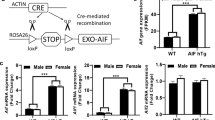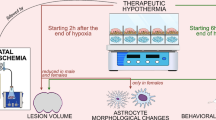Abstract
It was recently discovered that while under normal conditions inhaled nitric oxide (iNO) does not affect cerebral blood flow, it selectively dilates arterioles in the ischemic penumbra during experimental cerebral ischemia, thereby increasing collateral blood flow and reducing ischemic brain damage. The mechanism was verified in multiple models, but only in male animals. Our aim was to evaluate the effects of iNO on brain injury in neonatal males and females. Nine-day-old mice were subjected to unilateral hypoxia–ischemia (HI), using 10 % oxygen balanced with nitrogen, with or without 50 ppm NO. Brain injury 72 h after HI was reduced by iNO as judged by percentage of injury (−21.7 %), atrophy (−23.7 %), and total pathological score (−29 %). The injury was significantly reduced in males (−32.4 %, p < 0.05) but not in females (−7.1 %, n.s.). Neither the numbers nor the proliferation rates of neural stem cells in the dentate gyrus were affected by iNO. In summary, intraischemic iNO reduced neonatal HI brain injury in a gender-related manner.




Similar content being viewed by others
References
Lawn JE, Cousens S, Zupan J. 4 Million neonatal deaths: when? where? why? Lancet. 2005;365:891–900.
Shankaran S, Laptook AR, Ehrenkranz RA, et al. Whole-body hypothermia for neonates with hypoxic-ischemic encephalopathy. N Engl J Med. 2005;353:1574–84.
Zhu C, Kang W, Xu F, et al. Erythropoietin improved neurologic outcomes in newborns with hypoxic-ischemic encephalopathy. Pediatrics. 2009;124:e218–26.
Szabo C. Physiological and pathophysiological roles of nitric oxide in the central nervous system. Brain Res Bull. 1996;41:131–41.
Terpolilli NA, Kim S, Thal SC, et al. Inhalation of nitric oxide prevents ischemic brain damage in experimental stroke by selective dilatation of collateral arterioles. Circ Res. 2012;110:727–38.
Blomgren K, Hagberg H. Free radicals, mitochondria, and hypoxia-ischemia in the developing brain. Free Radic Biol Med. 2006;40:388–97.
Zhu C, Wang X, Qiu L, et al. Nitrosylation precedes caspase-3 activation and translocation of apoptosis-inducing factor in neonatal rat cerebral hypoxia-ischaemia. J Neurochem. 2004;90:462–71.
Peeters-Scholte C, Koster J, Veldhuis W, et al. Neuroprotection by selective nitric oxide synthase inhibition at 24hours after perinatal hypoxia-ischemia. Stroke. 2002;33:2304–10.
Nijboer CH, Groenendaal F, Kavelaars A, et al. Gender-specific neuroprotection by 2-iminobiotin after hypoxia-ischemia in the neonatal rat via a nitric oxide independent pathway. J Cereb Blood Flow Metab. 2007;27:282–92.
van den Tweel ER, Peeters-Scholte CM, van Bel F, et al. Inhibition of nNOS and iNOS following hypoxia-ischaemia improves long-term outcome but does not influence the inflammatory response in the neonatal rat brain. Dev Neurosci. 2002;24:389–95.
Muramatsu K, Sheldon RA, Black SM, et al. Nitric oxide synthase activity and inhibition after neonatal hypoxia ischemia in the mouse brain. Brain Res Dev Brain Res. 2000;123:119–27.
Wainwright MS, Grundhoefer D, Sharma S, Black SM. A nitric oxide donor reduces brain injury and enhances recovery of cerebral blood flow after hypoxia-ischemia in the newborn rat. Neurosci Lett. 2007;415:124–9.
Patrianakos-Hoobler AI, Marks JD, Msall ME, et al. Safety and efficacy of inhaled nitric oxide treatment for premature infants with respiratory distress syndrome: follow-up evaluation at early school age. Acta Paediatr. 2011;100:524–8.
Aaltonen M, Soukka H, Halkola L, et al. Inhaled nitric oxide treatment inhibits neuronal injury after meconium aspiration in piglets. Early Hum Dev. 2007;83:77–85.
Pansiot J, Loron G, Olivier P, et al. Neuroprotective effect of inhaled nitric oxide on excitotoxic-induced brain damage in neonatal rat. PLoS One;5:e10916
Kinsella JP, Cutter GR, Walsh WF, et al. Early inhaled nitric oxide therapy in premature newborns with respiratory failure. N Engl J Med. 2006;355:354–64.
Tanaka Y, Hayashi T, Kitajima H, et al. Inhaled nitric oxide therapy decreases the risk of cerebral palsy in preterm infants with persistent pulmonary hypertension of the newborn. Pediatrics. 2007;119:1159–64.
Mestan KK, Marks JD, Hecox K, et al. Neurodevelopmental outcomes of premature infants treated with inhaled nitric oxide. N Engl J Med. 2005;353:23–32.
Ballard RA, Truog WE, Cnaan A, et al. Inhaled nitric oxide in preterm infants undergoing mechanical ventilation. N Engl J Med. 2006;355:343–53.
Zhu C, Wang X, Xu F, et al. The influence of age on apoptotic and other mechanisms of cell death after cerebral hypoxia-ischemia. Cell Death Differ. 2005;12:162–76.
Rice 3rd JE, Vannucci RC, Brierley JB. The influence of immaturity on hypoxic-ischemic brain damage in the rat. Ann Neurol. 1981;9:131–41.
Zhu C, Wang X, Xu F, et al. Intraischemic mild hypothermia prevents neuronal cell death and tissue loss after neonatal cerebral hypoxia-ischemia. Eur J Neurosci. 2006;23:387–93.
Li H, Li Q, Du X, et al. Lithium-mediated long-term neuroprotection in neonatal rat hypoxia-ischemia is associated with antiinflammatory effects and enhanced proliferation and survival of neural stem/progenitor cells. J Cereb Blood Flow Metab. 2011;31:2106–15.
Vannucci RC, Vannucci SJ. Perinatal hypoxic-ischemic brain damage: evolution of an animal model. Dev Neurosci. 2005;27:81–6.
Zhu C, Xu F, Wang X, et al. Different apoptotic mechanisms are activated in male and female brains after neonatal hypoxia-ischaemia. J Neurochem. 2006;96:1016–27.
Du L, Bayir H, Lai Y, et al. Innate gender-based proclivity in response to cytotoxicity and programmed cell death pathway. J Biol Chem. 2004;279:38563–70.
Li H, Pin S, Zeng Z, et al. Sex differences in cell death. Ann Neurol. 2005;58:317–21.
Furchgott RF, Zawadzki JV. The obligatory role of endothelial cells in the relaxation of arterial smooth muscle by acetylcholine. Nature. 1980;288:373–6.
Huang Z, Huang PL, Ma J, et al. Enlarged infarcts in endothelial nitric oxide synthase knockout mice are attenuated by nitro-l-arginine. J Cereb Blood Flow Metab. 1996;16:981–7.
Moncada S, Erusalimsky JD. Does nitric oxide modulate mitochondrial energy generation and apoptosis? Nat Rev Mol Cell Biol. 2002;3:214–20.
Cornfield DN, Maynard RC, de Regnier RA, et al. Randomized, controlled trial of low-dose inhaled nitric oxide in the treatment of term and near-term infants with respiratory failure and pulmonary hypertension. Pediatrics. 1999;104:1089–94.
Vavilala MS, Roberts JS, Moore AE, et al. The influence of inhaled nitric oxide on cerebral blood flow and metabolism in a child with traumatic brain injury. Anesth Analg. 2001;93:351–3.
Cannon 3rd RO, Schechter AN, Panza JA, et al. Effects of inhaled nitric oxide on regional blood flow are consistent with intravascular nitric oxide delivery. J Clin Invest. 2001;108:279–87.
Kim-Shapiro DB, Schechter AN, Gladwin MT. Unraveling the reactions of nitric oxide, nitrite, and hemoglobin in physiology and therapeutics. Arterioscler Thromb Vasc Biol. 2006;26:697–705.
Endres M, Laufs U, Liao JK, Moskowitz MA. Targeting eNOS for stroke protection. Trends Neurosci. 2004;27:283–9.
Lundberg JO, Weitzberg E, Gladwin MT. The nitrate-nitrite-nitric oxide pathway in physiology and therapeutics. Nat Rev Drug Discov. 2008;7:156–67.
Ng ES, Jourd'heuil D, McCord JM, et al. Enhanced S-nitroso-albumin formation from inhaled NO during ischemia/reperfusion. Circ Res. 2004;94:559–65.
Fabian RH, Perez-Polo JR, Kent TA. Perivascular nitric oxide and superoxide in neonatal cerebral hypoxia-ischemia. Am J Physiol Heart Circ Physiol. 2008;295:1809–14.
Qiu L, Zhu C, Wang X, et al. Less neurogenesis and inflammation in the immature than in the juvenile brain after cerebral hypoxia-ischemia. J Cereb Blood Flow Metab. 2007;27:785–94.
Torroglosa A, Murillo-Carretero M, Romero-Grimaldi C, et al. Nitric oxide decreases subventricular zone stem cell proliferation by inhibition of epidermal growth factor receptor and phosphoinositide-3-kinase/Akt pathway. Stem Cells. 2007;25:88–97.
Moreno-Lopez B, Romero-Grimaldi C, Noval JA, et al. Nitric oxide is a physiological inhibitor of neurogenesis in the adult mouse subventricular zone and olfactory bulb. J Neurosci. 2004;24:85–95.
Zhang R, Zhang L, Zhang Z, et al. A nitric oxide donor induces neurogenesis and reduces functional deficits after stroke in rats. Ann Neurol. 2001;50:602–11.
Carreira BP, Morte MI, Inacio A, et al. Nitric oxide stimulates the proliferation of neural stem cells bypassing the epidermal growth factor receptor. Stem Cells. 2010;28:1219–30.
Tioseco JA, Aly H, Essers J, et al. Male sex and intraventricular hemorrhage. Pediatr Crit Care Med. 2006;7:40–4.
Hagberg H, Wilson MA, Matsushita H, et al. PARP-1 gene disruption in mice preferentially protects males from perinatal brain injury. J Neurochem. 2004;90:1068–75.
Donders J, Hoffman NM. Gender differences in learning and memory after pediatric traumatic brain injury. Neuropsychology. 2002;16:491–9.
Charriaut-Marlangue C, Bonnin P, Gharib A, et al. Inhaled nitric oxide reduces brain damage by collateral recruitment in a neonatal stroke model. Stroke. 2012;Sept. 4. doi: 10.1161/STROKEAHA.112.664243
Bonnin P, Leger PL, Villapol S, et al. Dual action of NO synthases on blood flow and infarct volume consecutive to neonatal focal cerebral ischemia. Exp Neurol. 2012;236:50–7.
Acknowledgments
This work was supported by the Swedish Research Council, the Swedish Childhood Cancer Foundation (Barncancerfonden), governmental grants from Agreement concerning research and education of doctors (ALF), the Swedish Medical Society (SLS), the Sten A. Olsson’s Foundation, the National Natural Science Foundation of China (to CZ; 31271152), the Wilhelm and Martina Lundgren Foundation, the Frimurare Barnhus Foundation, the Third Phase 211 project of Zhengzhou University, the Health Department of Henan Province, Edit Jacobson’s Donation Foundation, Kungl. Vetenskaps- och Vitterhetssamhället i Göteborg, the Gothenburg Medical Society, the Swedish Medical Society, Aina Wallström’s and Mary-Ann Sjöblom’s Foundation, the Ulla and Rune Amlöv Foundation, AFA Insurance, and the Swedish Society of Medicine.
Author information
Authors and Affiliations
Corresponding author
Rights and permissions
About this article
Cite this article
Zhu, C., Sun, Y., Gao, J. et al. Inhaled Nitric Oxide Protects Males But not Females from Neonatal Mouse Hypoxia–Ischemia Brain Injury. Transl. Stroke Res. 4, 201–207 (2013). https://doi.org/10.1007/s12975-012-0217-2
Received:
Revised:
Accepted:
Published:
Issue Date:
DOI: https://doi.org/10.1007/s12975-012-0217-2




